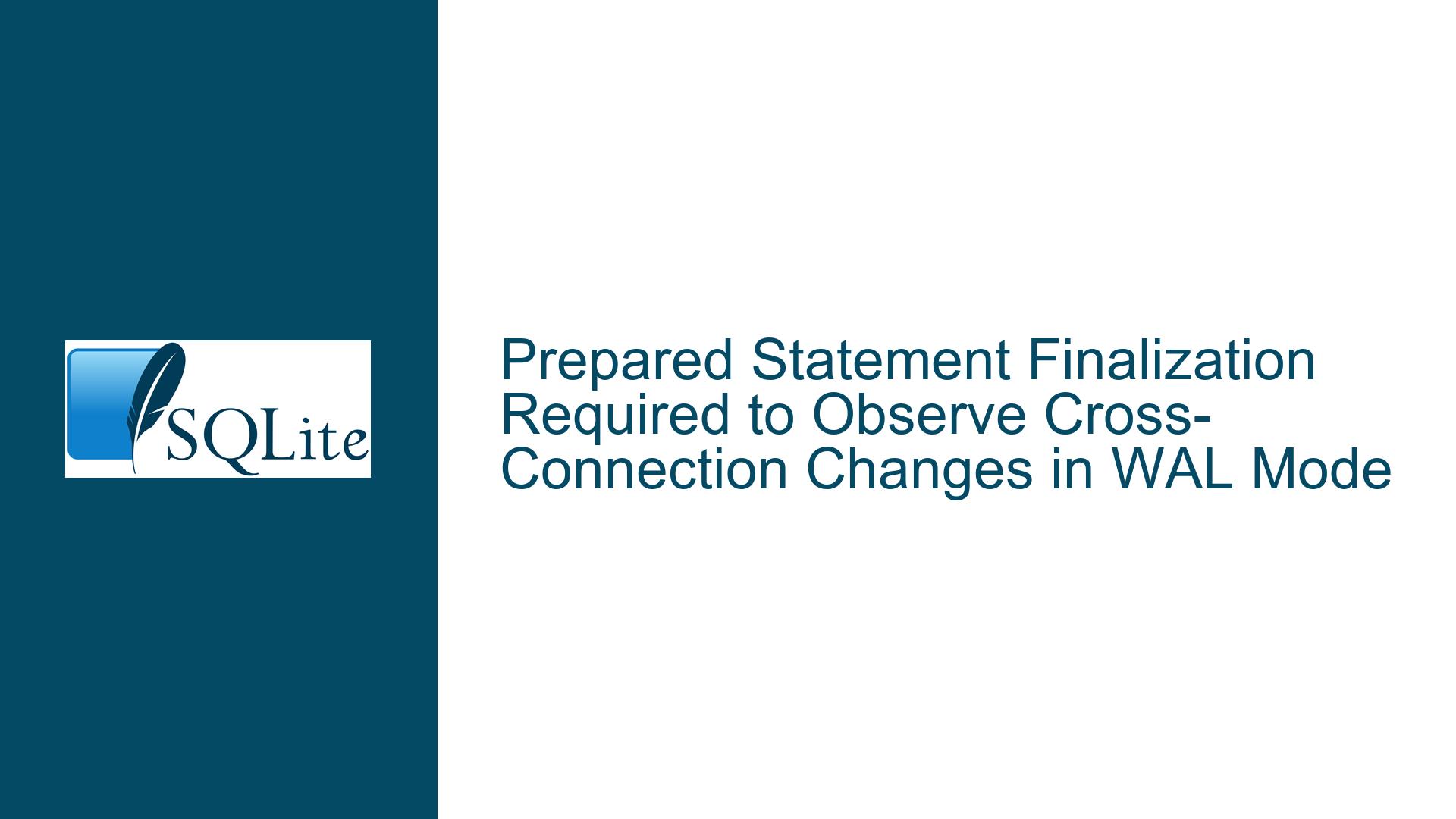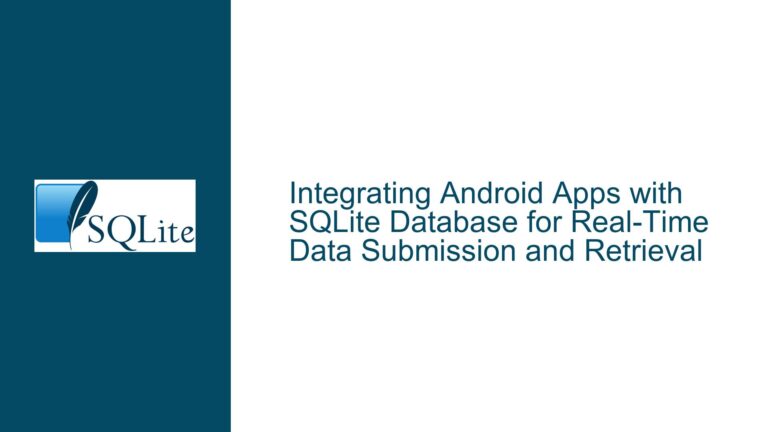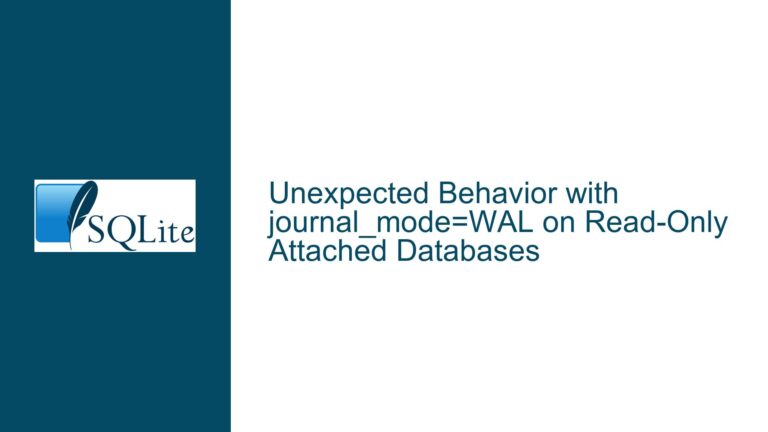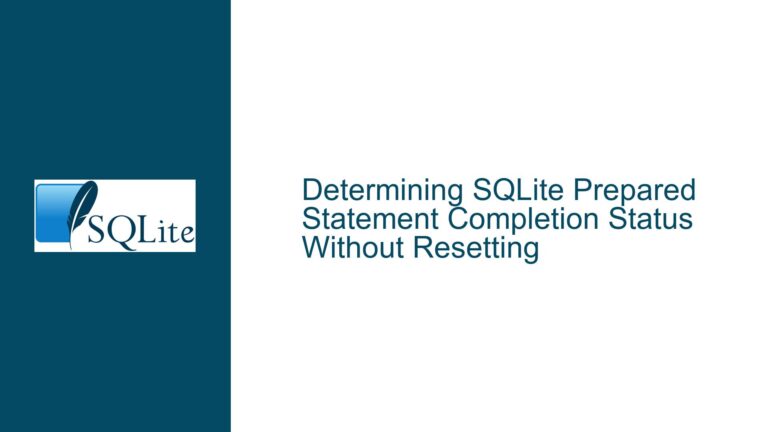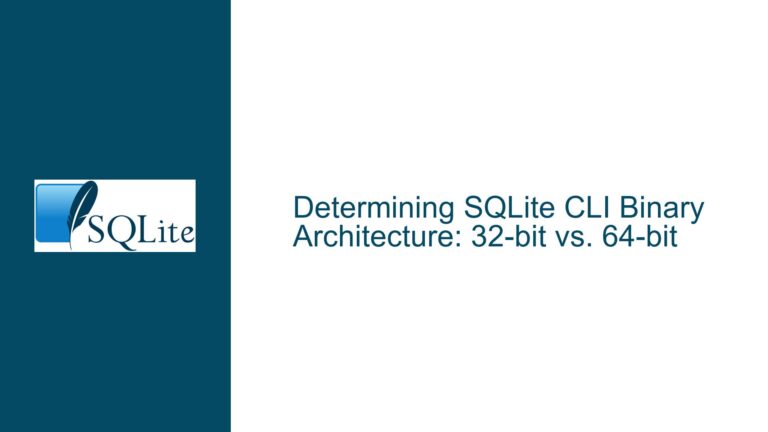Prepared Statement Finalization Required to Observe Cross-Connection Changes in WAL Mode
Transaction Isolation and Statement Lifecycle in Concurrent SQLite WAL Environments
Persistent Read Transactions Due to Unfinalized Prepared Statements
The core issue arises when a database connection operating in Write-Ahead Logging (WAL) mode fails to observe committed changes from another connection due to an unfinalized or unresolved prepared statement. This behavior is rooted in SQLite’s transaction isolation model and the lifecycle management of prepared statements.
When a read operation is executed via sqlite3_step() on a prepared statement (s1), SQLite initiates an implicit read transaction. This transaction remains active until the statement is either reset with sqlite3_reset() or finalized with sqlite3_finalize(). While this transaction is open, subsequent queries on the same connection will continue to observe the database state as it existed when the transaction began, even if other connections commit new changes. The problem manifests when a second prepared statement (s3) is created and executed on the same read connection while s1 remains unresolved. The connection’s read transaction remains pinned to the original snapshot, preventing visibility of writes from other connections until the initial transaction is closed.
This behavior is exacerbated in WAL mode, where readers and writers can operate concurrently. However, each reader connection maintains its own view of the database state for the duration of its transaction. The failure to finalize or reset s1 keeps the read transaction active, effectively "freezing" the connection’s view of the database.
Implicit Transactions, Statement Ownership, and WAL Snapshot Retention
Three primary factors contribute to this issue:
Implicit Read Transactions and Statement Lifecycle
SQLite automatically initiates a read transaction when aSELECTstatement is executed viasqlite3_step(). This transaction remains open until the associated prepared statement is reset or finalized. Unlike explicit transactions (initiated withBEGIN), implicit transactions are tied to the lifecycle of individual statements. If a prepared statement is not reset or finalized, the implicit transaction persists, preventing the connection from observing newer database states.In the provided example,
s1’s implicit transaction remains active becausesqlite3_reset()orsqlite3_finalize()is not called. Even thoughs3is a new prepared statement, it operates within the same connection and thus inherits the existing transaction context. The connection’s read view remains anchored to the state whens1was first executed.Connection-Level Transaction Isolation
SQLite enforces transaction isolation at the connection level. Each connection maintains its own transaction state, and changes from other connections become visible only when the local transaction is closed and a new one is started. Whens1is left unresolved, the read connection’s transaction remains open, ands3executes within this same transaction. The writer connection’sINSERTis committed to the WAL file but is not visible to the read connection until it starts a new transaction.WAL Mode and Snapshot Semantics
In WAL mode, readers retain a snapshot of the database state as of the start of their transaction. This allows concurrent read/write operations but introduces the requirement that readers must finalize transactions to advance their snapshot. The writer’s changes are appended to the WAL file, but the reader’s open transaction continues to reference the original database pages. Passive checkpoints do not resolve this because they only merge WAL content into the main database file; they do not force readers to update their snapshots.
Resolving Snapshot Staleness Through Statement and Transaction Management
Step 1: Enforce Strict Prepared Statement Lifecycle Discipline
Always reset or finalize prepared statements immediately after processing their results:
// After processing s1:
rc = sqlite3_reset(s1); // Ends the implicit transaction
// OR
rc = sqlite3_finalize(s1); // Destroys the statement and ends the transaction
Resetting s1 releases its lock on the database snapshot, allowing the connection’s next transaction to observe new changes.
Step 2: Use Explicit Read Transactions with Defined Boundaries
Wrap read operations in explicit transactions to control snapshot visibility:
// Read connection
rc = sqlite3_exec(reader, "BEGIN;", 0, 0, 0);
// Execute and process s1...
rc = sqlite3_exec(reader, "COMMIT;", 0, 0, 0); // Releases the snapshot
Explicit commits terminate the transaction, ensuring subsequent reads start a new transaction and see the latest data.
Step 3: Validate Return Codes for Busy Conditions
Check the return value of sqlite3_step() to detect SQLITE_BUSY or SQLITE_LOCKED errors, which indicate contention:
rc = sqlite3_step(s3);
if (rc == SQLITE_BUSY) {
// Handle contention (e.g., retry, abort, or notify user)
}
While less common in WAL mode, these checks are critical for diagnosing unanticipated locking scenarios.
Step 4: Optimize WAL Checkpointing Strategically
Although passive checkpoints do not force snapshot updates, aggressive checkpointing can minimize WAL file growth:
// On the writer connection after committing changes:
sqlite3_wal_checkpoint_v2(writer, NULL, SQLITE_CHECKPOINT_TRUNCATE, NULL, NULL);
This is supplementary and does not replace proper transaction management.
Step 5: Consider Read-Uncommitted Mode for Lower Isolation
If stale reads are unacceptable and write conflicts are rare, relax the reader’s isolation level:
sqlite3_exec(reader, "PRAGMA read_uncommitted = 1;", 0, 0, 0);
This allows the reader to see uncommitted changes but introduces risk of reading inconsistent states.
Step 6: Reuse Prepared Statements Where Possible
Instead of creating s3, reuse s1 after resetting it:
sqlite3_reset(s1);
rc = sqlite3_step(s1); // Starts a new transaction with current snapshot
This avoids redundant statement compilation and ensures transaction continuity.
By methodically addressing statement lifecycle management, transaction boundaries, and WAL snapshot semantics, developers can ensure cross-connection visibility while maintaining SQLite’s concurrency advantages. The interplay between implicit transactions and connection-level isolation demands rigorous API discipline, particularly in multi-connection architectures.
